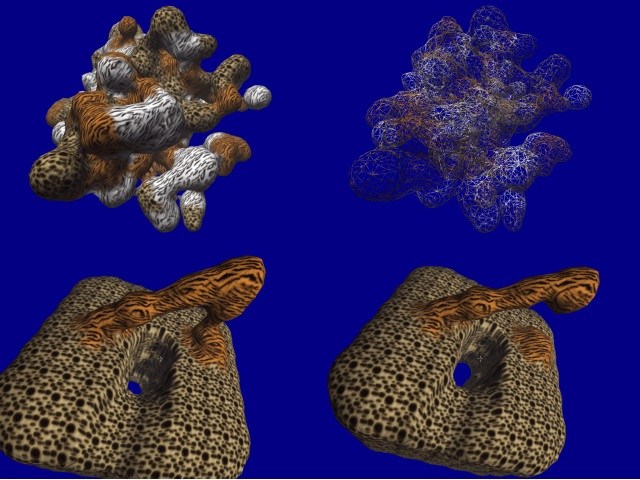 |

Submitted by , posted on 24 April 2002
|
 |

Image Description, by

NOTE - Not a terrain engine, but it can do terrain.
These are some shots from an engine I've been working on for about 2
years. I've still got a long way to go before it's finished, but since
I finally got a windows version up and running I decided to post an
IOTD.
I originally posted an IOTD quite awhile back, some people refered to it as green swiss cheese. I've decided to call the top left image furry swiss cheese (I'm using animal skin textures for my test now). The top right image is the left image in wireframe. The bottom left shows the top side of a smooth cube with some odd structures on it. The bottom right shows a few seconds later with some edits applied. The edits are near-realtime.
Originally the engine was supposed to be a voxel engine, inspired from
some work by Stan Melax. But as I kept working on it I
ended up switching it to metaballs. It seems to me that voxels are
kinda like a degenerate form of metaballs anyway, at a certain area one
unit squared they have a field value of infinity and everywhere else
they are zero. Metaballs have some nice properties that voxels don't
give you like simple normal calculation and reduced memory overhead.
Well now the engine takes a whole lot less memory than before and I've
gotten edits much faster. This demo allows you to edit in one of two
ways. You can fire (spacebar) a bullet that hits the terrain and
destroys it (actually adds negative metaballs). You can also move to a
spot and hit 'E' and deposit a positive metaball in your location. Both
of these will be quickly calced and added to the new scene, on a fast
system in less than a second. Please read the readme.txt before you run
the program.
I've got ideas to build a game, that allows real-time deformation of the
terrain (grenades, bombs, etc!). Also when I add the physics system I
can use the field values from the metaballs to calculate gravity so that
you can walk over the surface of the metaball structure. Think of the
game "Tribes" in space, fighting on deformable metaballs.
It supports LOD using a modified binary triangle tree algorithm. The
BTT seemed a bit slow, sending single triangles to the screen at a time,
so instead of a triangle being a leaf node in the BTT, a large group of
triangles are the leaf node of the BTT. Also LOD only occurs in the XY
plane. Z LOD always stays the same. The meshes that exist in the leaf
nodes of the BTT are optimized for the Geforce vertex cache.
Ok, now for my feature list:
Underlying data structure are metaballs.
Dynamically Generated Mesh and Texture coordinates.
Terrain doesn't have to be flat. It can have holes and caves in it
easily.
Allows modifying of the metaballs which in turn causes all affected
meshes to be recalculated (very fast!).
Real time editing (now it's fast, but it will get MUCH faster!)
LOD implemented using a variation of binary triangle trees.
Saving and Loading of all data structures.
Console can change most system variables while the app is running.
Implemented in C++ and OpenGL under Linux, ported to Windows using
Borland C++ (only tested under XP). Currently only tested on TNT2,
Geforce2MX, Geforce2 GTS(thanks Zelcious).
Multithreaded (A little jerky under windows, still working on
figuring that out).
The longest project I've ever been able to concentrate on without
getting distracted (Hey that's a very cool feature!)
To download the source code, linux binary, or windows executable go to http://iris.homeip.net/jstrohm. Larger screenshots are also available.
Prebuilt maps are available as a seperate download (they aren't very
fancy!).
|
|

